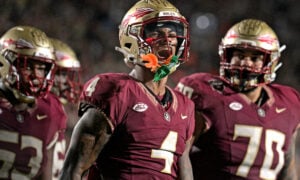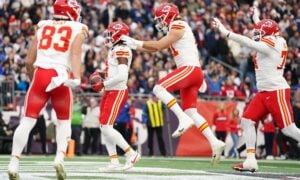On John Fox and Running Expectations
 Editor’s Note: This article is part of an ongoing series of articles from some of the most established, respected members of the DLF forum. These articles may not always reflect the opinions the DLF staff, but they will always be high quality & thought provoking, and are intended to provide a platform for sharing the insights and opinions from some of the best ffb minds around. Enjoy! – DLF Staff
Editor’s Note: This article is part of an ongoing series of articles from some of the most established, respected members of the DLF forum. These articles may not always reflect the opinions the DLF staff, but they will always be high quality & thought provoking, and are intended to provide a platform for sharing the insights and opinions from some of the best ffb minds around. Enjoy! – DLF Staff
Speculation exists throughout the NFL and runs even more rampant among Fantasy Football owners. Fantasy in and of itself implies something: how do I want things to be? Fantasy prognostication inundates many websites, magazines, and blogs. Forums are a great medium to share our visions of how things will go – according to our perceptions. In our fantasy worlds our players will do exactly what we envision them to do. Our first-round picks will rush for 2,000 yards and 12 touchdowns or catch 111 passes for 1,500 yards, as expected (by us!). We find a few young players that we think will be the next big thing – boosting our teams into Championship contention. Much of this is what it is, right? Speculation. But how do we arrive there?
While gut-feelings are often emphatically shouted from the ALL-CAPS rooftops in lesser fantasy forums, I’d like to think that most long-time members and even newer participants of this site often provide compelling cases and interesting discussion about our players and the NFL. That said, much of what makes fantasy football special can be summed up in one word: numbers.
As NFL fans, we love explosive plays and explosive players, one-handed catches, and beastly runs (I had to get that in here, didn’t I?). On game-days with our fantasy teams we rely entirely on one key thing: production.
Dynasty football includes a cold triumvirate of numbers, speculation, and production. Unless we want our hearts to lead us astray or favoritism to derail us, we must pay special attention to numbers. Speculation is fun, but roduction is what matters most. One key factor that affects production besides the individual players is: Situation.
With the potential production of both Denver and Carolina’s main running back situations in mind, let’s review some numbers and information regarding John Fox and his Running Back situations in Carolina before landing in Denver as the Broncos new Head Coach in 2011. The fate of Knowshon Moreno, Jonathan Stewart, and DeAngelo Williams will have some light shed on them, but mostly I want to help to better understand what to expect from Denver with a seemingly run-first Head Coach in John Fox now calling the shots.
Everybody in Dynasty Fantasy Football spends some amount of time creating their own rankings and determinations about how players will perform (production). I will be focusing on the changing situation in Denver, including John Fox’s history with his respective running games and running backs while with the Carolina Panthers from 2002-2010. I’ll break down some numbers and provide a few reasonable conclusions (speculation) drawn largely from John Fox’s history in Carolina beginning with the 2003 season (more numbers). Thank God we won’t have to cover Jake Delhomme, right? Let’s get to it.
This first group of numbers represents the season; number of combined carries between the Panthers’ top 2* RBs under Coach Fox and the individual carries and receptions of those top runners.
[Year – Carries among top 2 Running Backs, Receptions] ’03 – 431 carries among top 2 RBs Stephen Davis 318, 14 *DeShaun Foster 113, 26
’04 – 344 among top 3 backs (major injuries to the backfield) Nick Goings 217, 45 Hoover 68, 21 Foster 59, 9
’05 – 385 carries Foster 205, 34 S.Davis 180, 5 (age 31)
’06 – 348 carries Foster 227, 32 **DeAngelo Williams 121, 33
’07 – 391 carries Foster 247, 25 (his last season of rookie deal at age 27, subsequently became UFA and signed with S.F.) DWill 144, 23
’08 – 457 carries DWill 273, 22 **Jonathan Stewart 184, 8
’09 – 437 carries Stewart 221, 18 DWill 216, 29
’10 – 368 carries (amid abysmal pass offense and equally horrific defense) Stewart 178, 8 Mike Goodson 103, 40 DWill 87, 11 (DWill’s final season of rookie deal at age 27, set to become UFA)
Notes (2): 1. *2004 and 2010 seasons included a 3rd rusher with significant carries due to injuries atop the depth- chart. It can be presumed that if it were not for injury, those carries would have gone mostly or entirely to the top 2 runners, keeping in line with the surrounding seasons of data.
2. **Rookie Year We’ll begin the numbers breakdown by starting with DeShaun Foster, who was drafted the first year Fox began coaching the team in 2002. Foster spent his rookie year on injured reserve. After finishing his second season with 113 carries, he finally began to get a more relevant workload in his 3rd season when, for the first time in his career, he topped 200 carries. Foster had missed most of another season, 2004, with just 59 carries.
Foster became even more involved, finally, in 2005 when Stephen Davis was age 31 and his career nearly over. Both backs were coming of lost seasons due to injury in 2004. So, because of that lost season and a quality veteran back already on the roster in Davis, it took until Foster’s 4th season to lead the team in carries for the first time. Despite being the teams feature back in 2006 and 2007, Foster never topped 1,000 yards with Carolina and averaged a paltry 3.5 yards per rush his final season with the team.
2006 also happened to be Foster’s 4th season, 3rd as the team’s leading rusher, and same year DeAngelo Williams was drafted with the 27th pick in the first round.
Williams (or DWill) would wait his turn and in his 3rd season (and first with Foster no longer on the team), would go on to lead team in carries for the first and only time in 2008. This was DWill’s breakout campaign which coincided with the Jonathan Stewart being drafted 13th overall (also 2008). DWill had never carried the ball more than 144 times prior to that. He surprised by toting the rock 273 times that season and would go on to carry the mail just 303 times over the course of the next two seasons – mainly due to injuries. Stewart was probably drafted in part because DWill’s contract was close to up and the fact that Williams had never carried a full load before.
It should also be noted that Carolina has never had a history of being big spenders. In fact, the Panthers signed zero UFAs (Unrestricted Free Agents) in 2009 or 2010 and signed just one UFA in 2007. It was reported by some that the 5’9, 217lb DWill may have been considered undersized at the time. This pre- dates the growing trend of shorter/smaller RBs finding great success like Ray Rice, Jamaal Charles, and Ahmad Bradshaw, so the speculation about whether he could handle a full, every-down load was valid.
Perhaps he was undersized – at least for the load John Fox wanted him to withstand. That theory proved even more valid when DWill was oft-injured following his 273-carry season in 2008. He was hurt in ’09 with 3 games missed plus time in others and dropped to 216 carries that season. In ’10 season DWill had 10 games missed due to injury: only 87 carries. This swung carries in Stewart’s favor both of those seasons, Stewart’s second and third with the team, 2009-2010.
Now, let’s evaluate how the backs were used from a coaching perspective and reveal some of John Fox’s philosophy when it comes to his running backs.
Foster, Williams, and Stewart were drafted within the first 34 picks of their draft-classes, with Williams and Stewart being 1st-round selections and Foster a 2nd-rounder. As we know, rookie contracts are usually 4 seasons before players become UFAs. In ’06 and ’07, Fox stuck with Foster despite DWill’s presence. DWill got his chance only when Foster’s rookie deal expired and he moved on to sign with San Francisco. I suspect, based on the GM history with Carolina that this year will reveal DWill moving on to another team via free agency. His rookie deal has expired and he’s likely to walk as a UFA to another team, especially considering the team’s penchant for being frugal about free agency.
The Franchise Tag may be a possibility for DWill, but that is an 8.156 million-dollar investment when you already have a player who’s proven more than capable doing the job at the rate of a 1.31 million-dollar base salary for 2011. With a Salary Cap more than likely re-implemented upon the completion of a new CBA (Collective Bargaining Agreement), paying your top two running backs over 10-million in base salary might not be the best cap-management strategy. Does re-signing DWill or tagging him make sense? Probably not. Who knows: there may be a team out there willing to pay him a fortune, but age 28 RBs and mega-deal contracts typically aren’t good spending, either. Well, there are always the Bucs (see: Derrick Ward: 4 years, 17-million) and the Dan Snyder’s of the world (see: Team, Redskins).
Fortunately for Carolina they once again have another young RB in place already in Jonathan Stewart. Well, two. Mike Goodson should retain the #2 RB role with the team and Tyrell Sutton has also shown flashes. With Stewart, Goodson, and perhaps Sutton all capable players (or elite in Stewart’s case), I think its unlikely DWill returns to the Panthers – a team with many problems throughout the roster and running back is not one of them.
Now let’s look into John Fox’s team trends with regards to his backfields with an eye toward what we might expect now that he’s in Denver.
The historical numbers reveal some great seasons of RB ‘touches’ under Fox. John Fox’s teams averaged 451 carries from 2002 through 2010. These numbers include two different offensive coordinators: Dan Henning (2002–2006) and Jeff Davidson (2007–2010). Marty Hurney was the GM (General Manager) for Fox’s entire tenure as HC of the Panthers and remains in that role with the team, despite the departure of Fox to Denver and subsequent hiring of new Panthers HC Ron Rivera.
How might this affect Denver and Knowshon Moreno and the Denver Broncos backfield? Let’s keep looking at some pertinent numbers from the Panthers under John Fox.
| Year | Team Carries | NFL Rank in Team Carries |
| 2002 | 452 | 13 |
| 2003 | 522 | 2 |
| 2004 | 422 | 22 |
| 2005 | 487 | 10 |
| 2006 | 423 | 24 |
| 2007 | 451 | 9 |
| 2008 | 504 | 6 |
| 2009 | 525 | 2 |
| 2010 | 428 | 15 |
It’s certainly notable that John Fox’s Panthers averaged 468 carries per season during his tenure. The NFL average during this timeframe was 444. Furthermore, Carolina’s backfield enjoyed 3 seasons of over 500 rushing attempts. In 7 of 9 seasons, his teams were in the NFL’s top-15 for rushing attempts, including five top-10 rushing squads. Except for the ’04 and ’10 seasons where injuries forced a 3rd back to get significant carries, Carolina’s top 2 RBs averaged 385 combined carries per season and accounted for approximately 85% of the team’s rushing attempts throughout Fox’s 2002-2010 tenure. Great. More numbers – but what does this mean?
When looking at Carolina’s philosophy about drafting and playing those RBs, it seems pretty simple. The idea being that you play the veteran/incumbent runner; draft a young back with a couple of seasons to prepare for life without the current feature-back. You begin to work the younger back in and when the veteran breaks down or hits free agency, you move on to the younger back full time, having drafted the departed feature-back’s replacement ahead of time. It makes sense to wear out the incumbent. You’ll have the younger player longer and he can be worked in and learn the intricacies of the NFL while gaining experience and utilizing an NFL-caliber strength and conditioning program to prepare for a future, feature-back role.
Jonathan Stewart is ready for that role in Carolina. With any type of passing-offense improvement there, Stewart is going to go gangbusters.
Now, how much this is the philosophy of Marty Hurney, John Fox, or both we can’t really know exactly. However, what we can learn from this set of numbers is substantial. There are a few takeaways in looking at the data. First, John Fox is a run-first minded coach, preaching defense (his background) and ball-control. He often leans on an incumbent or veteran starter. A second running-back is often used and gets significant touches due in large part to the sheer number of rushing attempts and passes to his running backs. We don’t know how the GM in Denver will draft, but we can see that a second back will be needed if Fox continues stay with the philosophy he’s relied on since at least 2002.
I firmly believe that John Fox will lean on the ground-game and the incumbent starter Knowshon Moreno. Whether the Broncos add another quality RB (Lance Ball and Correll Buckhalter aren’t cutting it) is anyone’s guess. I don’t expect the team to sign an expensive free agent running back with so many holes across the entire roster to be filled, particularly on defense. We should be able to forecast the similar numbers for Moreno regardless of whether a competent second running back is added or emerges. But those numbers aren’t even the best part!
Regardless of the quality of overall offense and rushing offenses in Carolina under Fox, he has ALWAYS remained steadfast in his commitment to the run. Despite the performance of his runners, he has proven true to his philosophies of riding the veteran/incumbent until the wheels fall off. Regardless of the team’s success he has undying loyalty to the ground game.
Let’s go back to this block of numbers and add in the team’s record during the past five years:
| Year | Team Carries | NFL Rank | W-L Record |
| 2006 | 423 | 24 | 8-8 |
| 2007 | 451 | 9 | 7-9 |
| 2008 | 504 | 6 | 12-4 |
| 2009 | 525 | 2 | 8-8 |
| 2010 | 428 | 15 | 2-14 |
The theme for John Fox’s teams, though preposterous, would seem to be something like this: “Run no matter what and if you win, so be it. “ The numbers tell the story.
The player who stands to gain the most from all this is Knowshon Moreno. Only the second half of 2010 did we finally get to see solid performance from Moreno. Later, in-season, his pass-happy coach Josh McDaniels was jettisoned before the fans could stone him to death. Enter John Fox. If we project what to expect from Moreno based on historical evidence and his performance thus far in his young career we can include the normal carries and receptions provided by John Fox’s top two running backs those past five seasons in Carolina. While the team carried 477 times on average over that timeframe, the top two runners combined for 400 carries on average the past five seasons. One big thing to distinguish here is in the division of carries is that in Carolina Fox had a quality second back to share the load with given the presence of two first-round runners in Williams and Stewart, with Goodson playing well when called upon in 2010. In Denver, Fox currently does not have that luxury. Unless another quality runner is added, Moreno being the veteran/incumbent starter will receive the bulk of those touches and more than likely not nearly the split Fox used the previous five seasons. Even so, Moreno is in line for a big workload in 2011.
The final 8 games of 2010 Moreno averaged 5.0 yards per carry with 4.3 for the season. His career YPC is 4.0. We can split the difference.
Projected 2011 Rushing: 275-4.5-1,237
The Panthers top two running back data also means 47.6 receptions to split between the top two runners. An even split would fall short of both Moreno’s capabilities and strengths, including good hands and moves in space. Perhaps 2010 will be closer to the norm for Moreno. Mike Goodson caught 40 balls in 2010 as a backup.
Moreno has 65 receptions in two years, averaging 32.5 receptions per season. Fox’s top two runners average 47.6 combined receptions per season. We can safely give Moreno 30 receptions at his career average of 9 yards per catch.
Projected 2011 Receiving: 30-270
Moreno has 17 touchdowns in his two year career. We’ll split the difference and add to it (conservatively) in order to account for his projected increase in touches (307 total).
2009: 275 touches 9TDs
2010: 219 touches 8TDs
Projected 2011 Touchdowns: 11
Put it altogether and we have a stat-line that isn’t completely arbitrary or based purely on fantasy speculation. It’s backed by seasons of data under John Fox and the two-year profile of proven production Moreno has created for us.
Projected Totals: 1,507 yards, 11 TDs, 30 Rec for 270 yards = 246.7 Fantasy Points
These totals would put Moreno at RB10 in Dynasty PPR leagues based on 2010’s finish. And, I think considering John Fox’s influence and track-record the numbers are fairly conservative. If we recall the multiple 500-carry seasons and unfailing determination to continue running the ball under John Fox, a top-5 finish is certainly possible. The only thing that can prevent that from happening is Moreno himself.
I think the final question most will point to in any discussion with Moreno is health. Moreno has been banged up a lot during his brief NFL career, having played 16 games in 2009 with 9 starts and 13 games with 13 starts in 2010. In his favor, Moreno will turn just 24 this summer.
Young backs often miss time in their early seasons, as we saw with DeShaun Foster (above) and many other backs in similar positions to Moreno. McFadden played 13 games with 5 starts his rookie year followed by 12/7 and then 13/13 his third season. Mendenhall went 4 games, 1 start his rookie year then 16/12, 16/16. Beanie Wells went 16/0 and 13/3 his first two years. Ray Rice? 13/4, 16/15, 16/15. LeSean McCoy had 16/4, 15/13 his rookie and sophomore seasons. Donald Brown? 11/1, 13/8.
When I spoke early about allowing a young back time to benefit from NFL-caliber strength and conditioning programs, as well as experience, I think it’s reflective in each of the running backs’ careers that I just mentioned. So while Moreno has had health questions, history of similar running back profiles tells us that Moreno’s third season has a great chance of being very successful. Under John Fox it happened that way for Foster and DeAngelo Williams in Carolina. It happened for most of the young backs above who are popular, talented, early-round prospects from recent NFL drafts.
The bottom line is that Moreno’s future looks very bright. He’s in the right situation to succeed, despite some people questioning whether or not he is a truly ‘elite talent’. Regardless of how he performs, Fox will stick with him. Regardless of how the team performs, Fox will keep running. Regardless of the presence of another runner in the future, Moreno will be the lead dog under Fox.
In seasons 2006, 2007, 2008 and 2009 the top Panthers RB had roughly 100 more carries than his backup.
As they say: ‘go with the touches’. Moreno will be getting plenty.
- On John Fox and Running Expectations - February 8, 2011

































































